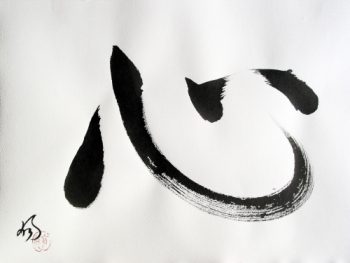~でいる Posted by Ginny on Mar 28, 2010
In English, the present continuous is formed by adding -ing to the verb. In Japanese, the present continuous is formed by adding ~でいる. To form the present affirmative polite, use the ending ~でいます/ています 彼女は公園で歩いています = She is walking in the park (かのじょ/彼女 = she. は = subject marking particle. こうえん/公園 = park. で = in…
Japanese Calligraphy Posted by Ginny on Mar 22, 2010

Early Japanese calligraphy was first influenced by Chinese calligraphy. The piece of writing on the left is titled がっきろん (楽毅論) and was produced by Empress Kōmyō (光明皇后). The Empress copied this text from the Chinese calligrapher Wang Xizhi. All the original works done by Wang Xizhi have been lost, so the only copy of this form…
First and Second Person Pronouns Posted by Ginny on Mar 19, 2010
In Japanese, first and second pronouns are frequently omitted, but just for review, here are some of the most common first and second person pronouns : (Note: because of the complexity of the Japanese language, i.e. politeness, gender, context etc. not all of the possible pronouns are listed below. However, this is a pretty comprehensive list) わたし/私…
Sentences with “May” Posted by Ginny on Mar 16, 2010
One way to ask for permission to do something is to use the construction ~てもいいですか 座ってもいいですか = May I sit down? (すわってもいいですか/座っていいですか = May I sit down?) To approve, you can use the construction ~てもいいですよ はい、すわってもいいですよ = Yes, you may sit down. (はい = yes. 座ってもいいですよ = you may sit down) To deny permission to do…
The Three Major Daimyō Posted by Ginny on Mar 13, 2010
There is a famous poem that Japanese children are taught to recite: (1) 鳴かぬなら、殺してしまえほととぎす, (なかぬなら、ころしてしまえほととぎす) (2) 鳴かぬなら、鳴かして見せようほととぎす (なかぬなら、なかしてみせようほととぎす) (3) 鳴かぬなら、鳴くまで待とうほととぎす (なかぬなら、なくまでまとうほととぎす) The first line means, “If the cuckoo does not sing, kill it”. This line refers to the だいみょう (大名) Oda Nobunaga (織田 信長). Nobunaga is considered one of the three great daimyōs. He was known…
More Quantifiers Posted by Ginny on Mar 10, 2010
Continuing from the previous post, here are some more quantifiers: 余り/あまり = not often, not much うどんは余り好きじゃありません = I don’t like udon that much. (うどん = udon. は = subject marking particle. あまり/余り = that much/not much. すきじゃありません/好きじゃありません = don’t like) 時々/ときどき = sometimes, from time to time. 私は時々公園で遊びます = I play at the park from…
Quantifiers Posted by Ginny on Mar 7, 2010
Quantifiers are words that express how often you do/don’t do things and how much you like/dislike certain things. Here is an example of a common quantifier よく: よく勉強します = I study often. (よく = often. 勉強します = べんきょうします/study) Another common one is とても: それはとても便利ですね = That’s very convenient, isn’t it? (それ = that. は =…


